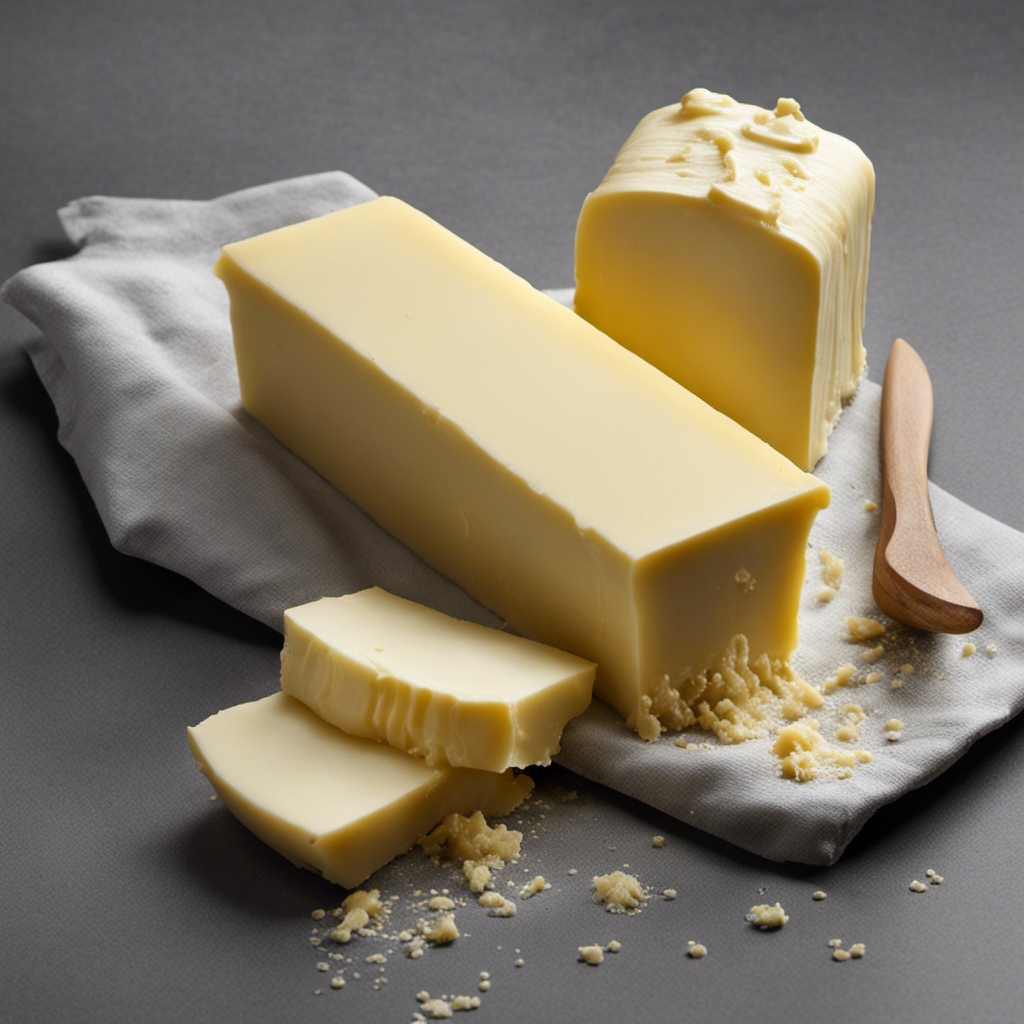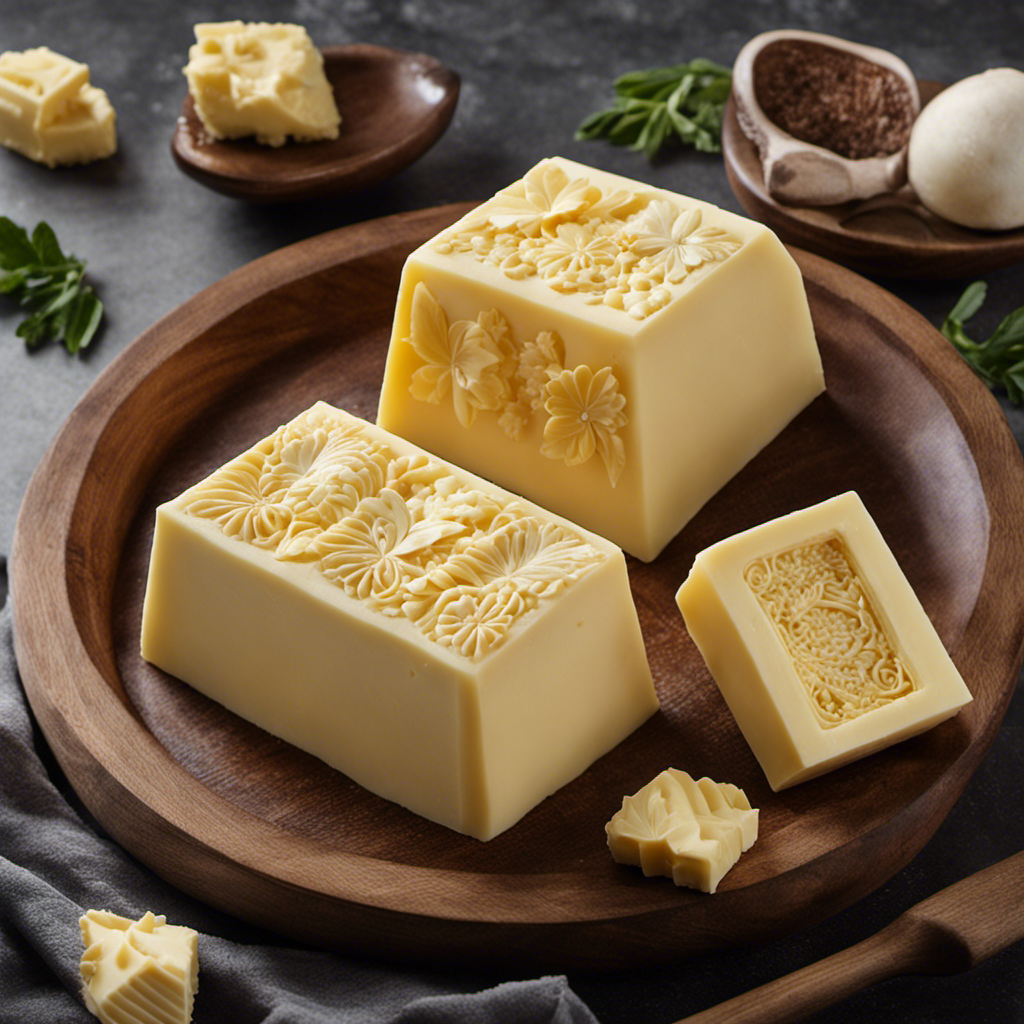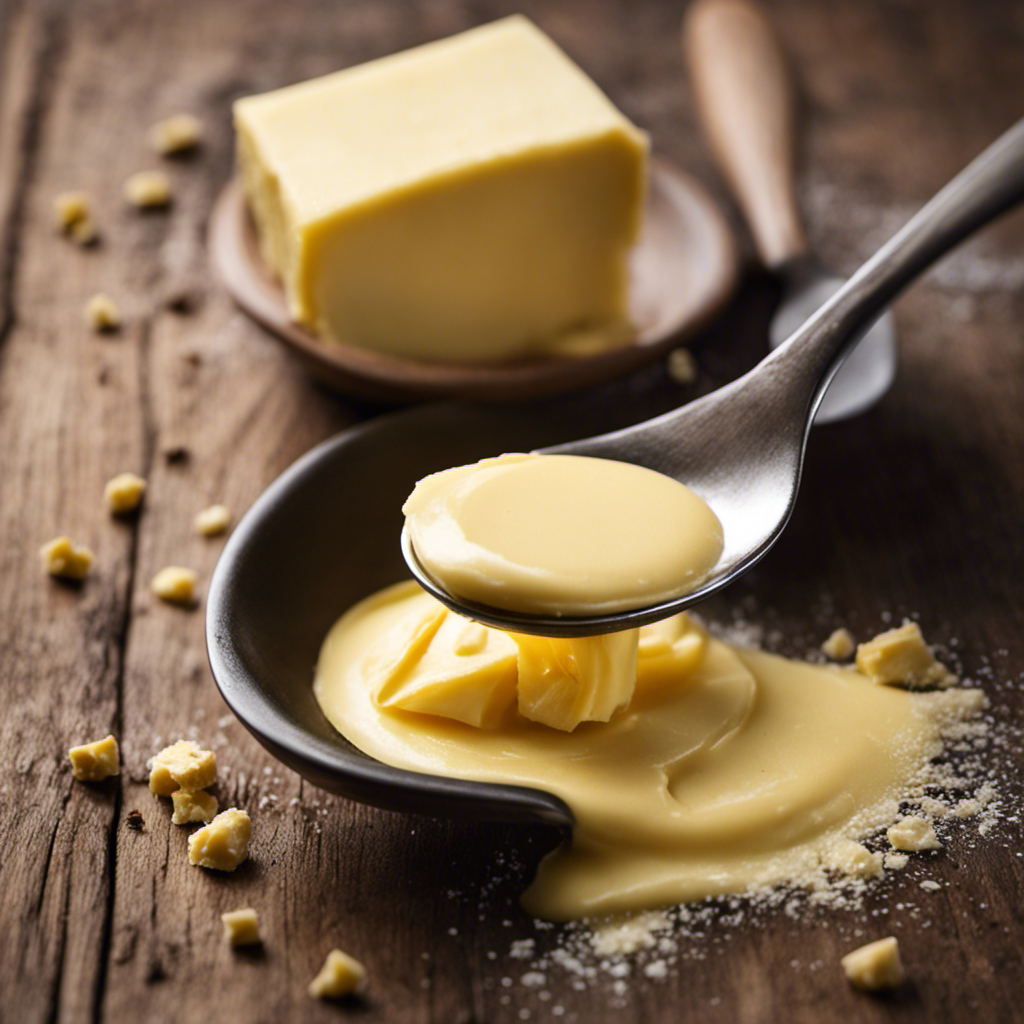Were you aware that 20% of households are unknowingly using rancid butter? This article will demonstrate a simple way to check if your butter has spoiled.
By examining its physical appearance, checking for mold or discoloration, assessing the texture and consistency, and conducting a taste test, you can ensure you’re using fresh and safe butter in your cooking.
Additionally, I’ll provide insights on shelf life and expiration dates to further guide you in maintaining butter quality.
Key Takeaways
- Rancid butter can be identified by its distinct yellow or brown color and greasy or oily texture.
- The sour smell of rancid butter indicates spoilage and consuming it can have negative effects on health.
- Mold or discoloration, ranging from yellow to brown, is a clear sign of rancidity in butter.
- Checking the expiration date and properly storing butter are crucial in preventing spoilage and maintaining its freshness and quality.
Physical Appearance and Smell
I can quickly tell if butter is rancid by examining its physical appearance and smelling it. Rancid butter has a distinct yellow or brown color instead of the usual pale yellow. It may also have a greasy or oily texture and a sour smell.
It’s important to identify rancid butter because consuming it can have negative effects on health. Rancidity occurs when the fat molecules in butter break down, producing harmful substances that can cause digestive issues and even food poisoning.
To prevent butter from going rancid, proper storage techniques should be followed. Butter should be stored in an airtight container in the refrigerator, away from strong odors. It’s also recommended to use butter within the expiration date for optimal freshness and taste.
Check for Mold or Discoloration
Inspect the butter for any visible signs of mold or discoloration. Mold can appear as fuzzy spots or patches, while discoloration can range from yellow to brown. These are indicators that the butter may be rancid and should not be consumed. Proper storage conditions play a crucial role in preventing butter from going bad. Butter should be kept in a cool, dry place away from direct sunlight and heat sources. Additionally, the packaging of butter can affect its shelf life. Butter that is packaged in airtight containers or wrapped tightly in foil or parchment paper helps to maintain its freshness. It is important to check the butter for any signs of mold or discoloration before using it to ensure its quality and safety.
| Storage Conditions | Butter Packaging |
|---|---|
| Cool and dry place | Airtight container |
| Away from sunlight and heat sources | Tightly wrapped in foil or parchment paper |
| Properly sealed packaging |
Butter Texture and Consistency
When I touch the butter, I can feel its texture and consistency. Butter is typically solid at room temperature, but it softens and becomes spreadable when warmed. This is due to its melting point, which is around 32 to 35 degrees Celsius (90 to 95 degrees Fahrenheit).
The texture of butter should be smooth and creamy, without any lumps or graininess. It should also be easy to spread and have a pleasant, rich flavor.
To maintain the texture and freshness of butter, it’s important to store it properly. Keep butter in an airtight container or wrap it tightly in wax paper or foil to prevent it from absorbing odors from other foods in the refrigerator. Additionally, store butter away from strong-smelling foods, as it can easily pick up their flavors.
Taste Test
After unwrapping the butter, I take a small bite to assess its flavor and freshness. The taste of butter can provide important clues about its quality and possible spoilage. If the butter tastes off or has a sour or rancid flavor, it is a clear sign that it has gone bad. Other signs of spoilage include a strong or unpleasant odor and a discolored or moldy appearance. Proper butter storage is crucial to prevent spoilage. It is recommended to store butter in the refrigerator, preferably in an airtight container to prevent absorption of odors. It is also important to check the expiration date and discard any butter that is past its prime. By conducting a simple taste test and being aware of the signs of spoilage, you can ensure that your butter is fresh and safe to consume.
| Signs of Spoilage | |||
|---|---|---|---|
| Off flavor | Sour or rancid taste | Strong or unpleasant odor | Discolored or moldy appearance |
Shelf Life and Expiration Date
I can easily determine the shelf life and expiration date of my butter by checking the label on the packaging. This information is crucial in ensuring that the butter I use is fresh and safe to consume.
Here are some key points to keep in mind regarding the shelf life and storage recommendations of butter:
- Butter typically has a shelf life of about 4-6 months from the date of production.
- It’s important to store butter in a cool and dry place, away from direct sunlight and heat sources.
- Keeping butter refrigerated can help extend its shelf life, especially during warmer months.
- If the butter starts to develop an off smell or taste, or if there are any signs of mold or discoloration, it’s best to discard it.
Frequently Asked Questions
Can You Still Use Butter if It Has a Slightly Sour Smell?
If butter has a slightly sour smell, it could be an indication of spoilage. When discussing whether butter can still be used, it’s important to consider other spoilage indicators as well. These include a change in color or texture, the presence of mold, or a rancid taste.
If only the smell is slightly sour, it might be safe to use, but it’s recommended to rely on other indicators as well to ensure the butter is still fresh.
Is It Safe to Consume Butter With a Slight Change in Color?
It’s important to consider if it’s safe to consume butter with a slight change in color.
The color of butter can vary depending on factors like the cow’s diet or the butter-making process.
However, if the change in color is accompanied by a strong, unpleasant odor or a sour taste, it could be a sign of rancidity.
It’s always best to err on the side of caution and discard butter that shows signs of being rancid.
What Should I Do if My Butter Has a Grainy or Clumpy Texture?
If my butter has a grainy or clumpy texture, I first check if it’s still safe to consume. However, without the context of how to tell if butter is rancid, it can be difficult to determine the cause.
It’s important to store butter properly to prevent texture changes.
If the butter is still safe, I can use it for alternative purposes like cooking or baking where the texture won’t matter as much.
Can Butter Taste Different Without Being Rancid?
Butter flavor can vary without the butter being rancid. Different factors like the cow’s diet, processing methods, and storage conditions can all affect the taste of butter.
However, if there are signs of rancidity, such as a sour or off smell, a yellow or brown color, or a bitter taste, then it’s likely that the butter has gone bad.
It’s always best to trust your senses and discard any butter that appears to be rancid.
How Can I Extend the Shelf Life of Butter Past Its Expiration Date?
To extend the shelf life of butter and preserve its freshness past its expiration date, there are a few things I’ve found helpful.
First, make sure to store it in an airtight container in the refrigerator. This will help prevent exposure to air and moisture, which can accelerate spoilage.
Additionally, you can also freeze butter to extend its shelf life even further. Just make sure to wrap it tightly in freezer-safe packaging.
These methods have helped me keep my butter fresh for longer periods of time.
Conclusion
In conclusion, determining whether butter is rancid can be quite a task. By relying on our senses and conducting various tests, we can gauge its freshness.
Remember, it’s always better to be safe than sorry when it comes to consuming questionable butter. So next time you’re unsure, trust your instincts and give it a thorough inspection. After all, who doesn’t love a little adventure in their dairy aisle?










